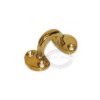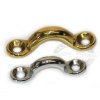Greg Nolan
enthusiast
I am considering installing pad eyes on both ends of a couple of my canoes, to allow attachment of painters and to use as tie-down points when car-topping.
What do you all think about the use of eye pads, and where and how should they be installed?
I am looking at two styles:


Should they be installed on the top of a deck, or possibly under the deck (where they would be out of the way)?. I know that Morris used to install them at the end of the stem on the floor of the canoe -- but we often tuck things in that space -- a knapsack with lunch, water, a spare pfd, the bow paddler’s feet, etc. -- that would interfere with tying on a painter.
Does having a separate ring through the eye pad add anything except something to rattle and chip at deck varnish?

It seems to me that some considerable strain might be placed on the eye pad -- when lining the canoe through a rapid, or on top of a car at 70 mph if the primary tie-down failed. Is simply fastening a pad eye down with 2 screws strong enough, given that the screws would have to be short -- shorter than the thickness of the deck? Would using a 4 screw pad eye make a useful difference? Or would using through-bolts and nuts be worth the little extra trouble?
At present, we fasten painters or tie-down lines to short loops of rope run through holes bored in the decks of one canoe (by a previous owner), or through the spaces between ribs on another.


While this works, it is just a bit too make-shift looking, especially on our new (for us), nicely restored OT Ideal.
Lots of canoes have them, lots do not. I'd appreciate hearing pros and cons.
What do you all think about the use of eye pads, and where and how should they be installed?
I am looking at two styles:


Should they be installed on the top of a deck, or possibly under the deck (where they would be out of the way)?. I know that Morris used to install them at the end of the stem on the floor of the canoe -- but we often tuck things in that space -- a knapsack with lunch, water, a spare pfd, the bow paddler’s feet, etc. -- that would interfere with tying on a painter.
Does having a separate ring through the eye pad add anything except something to rattle and chip at deck varnish?

It seems to me that some considerable strain might be placed on the eye pad -- when lining the canoe through a rapid, or on top of a car at 70 mph if the primary tie-down failed. Is simply fastening a pad eye down with 2 screws strong enough, given that the screws would have to be short -- shorter than the thickness of the deck? Would using a 4 screw pad eye make a useful difference? Or would using through-bolts and nuts be worth the little extra trouble?
At present, we fasten painters or tie-down lines to short loops of rope run through holes bored in the decks of one canoe (by a previous owner), or through the spaces between ribs on another.


While this works, it is just a bit too make-shift looking, especially on our new (for us), nicely restored OT Ideal.
Lots of canoes have them, lots do not. I'd appreciate hearing pros and cons.








